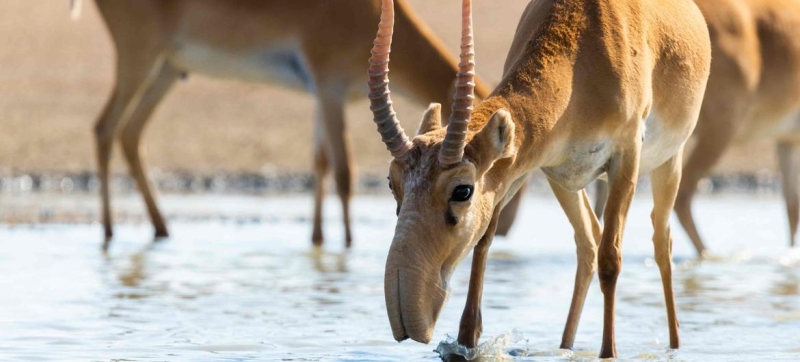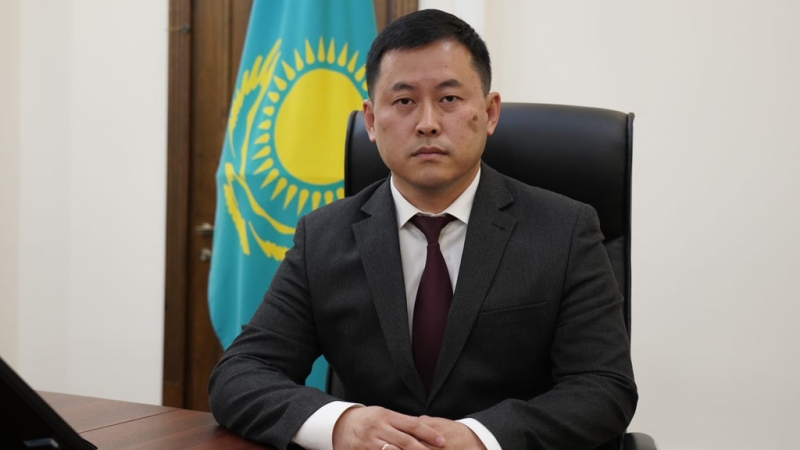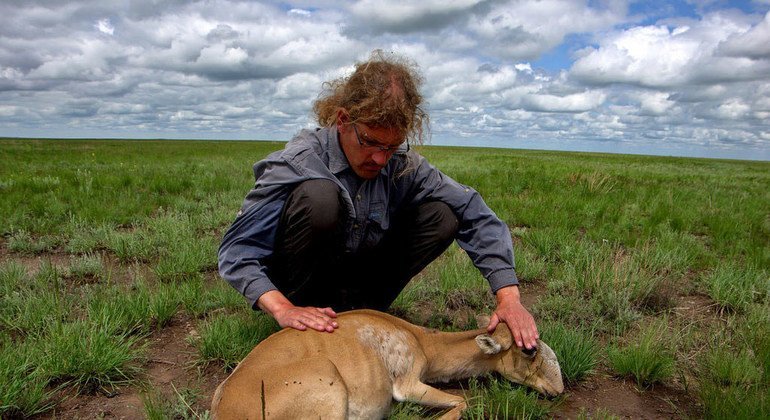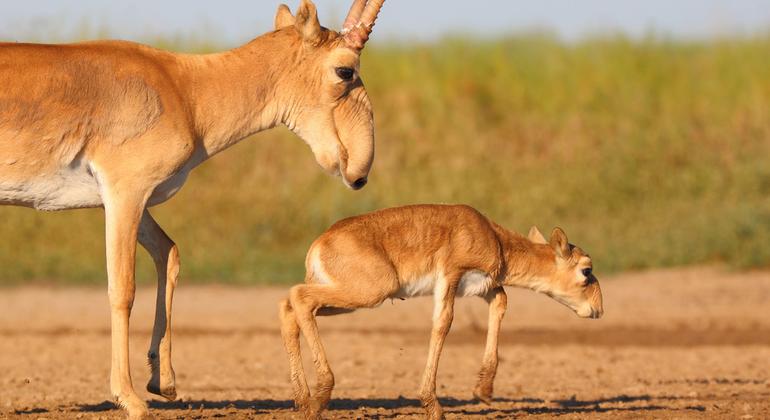
. The rapid growth of the saiga population is called the “Kazakh miracle”. Kazakhstan: saigas were saved from extinction, but rapid population growth led to unexpected problems Climate and Environment
The number of Red Book saigas in the Kazakh steppes has already exceeded two and a half million. The rapid growth is called the “Kazakh miracle”. The United Nations Development Program (UNDP) made its contribution to the rescue of saigas, together with other international organizations. This material from Kazakhstan is dedicated to the International Day of Biodiversity.
Saiga Antelope Rescue
The saiga is one of the “brands” of Kazakhstan, not only because 98 percent of the population lives on the territory of this Central Asian republic, but also because, thanks to the unique experience, this species of animal was not only preserved, but also achieved noticeable reproduction.
“And the whole world is looking at us to see how much we can continue to preserve them. Many international scientists call the rescue of the saiga in our steppes the “Kazakh miracle”, since, in their opinion, there is no such precedent anywhere in the world for saving steppe antelopes that were on the verge of extinction. There were only a few of them left,” Andrey Kim, a representative of the Ministry of Ecology and Natural Resources of Kazakhstan, said in an interview with the UN News Service.

Representative of the Ministry of Ecology and Natural Resources of Kazakhstan Andrey Kim.
At the end of last year, the International Union for Conservation of Nature (IUCN) announced the transfer of the Red List saiga from the Critically Endangered category to the Near Threatened category. Over the course of 20 years, it was possible to achieve not only the conservation of saigas, but also the restoration of the population from 21 thousand individuals in 2003 to 1.9 million in 2023, that is, almost ten times.
At the same time, the famous Hollywood actor Leonardo DiCaprio spoke about this on social networks. “Congratulations to the government of Kazakhstan, which has invested heavily in anti-poaching initiatives, strong law enforcement agencies and the creation of new protected areas. Their collaboration with conservation organizations, universities and scientists is a shining example of true conservation success based on collaborative efforts,” the actor wrote.
“Such a conservation outcome steppe antelope was achieved with the expert support of many international organizations, including the UNDP,” noted Andrey Kim.
According to his information, after an annual aerial survey in This year, the number of saigas in Kazakhstan may already reach 2.6 million individuals, and taking into account the measures taken in the republic to protect saigas after the spring lambing, by autumn in Kazakhstan the population is predicted to increase to 3.6 million.
“This is three times higher than the historical number of 1.2 million individuals, according to chronicles and reference materials of the Soviet and pre-Soviet periods,” the ecologist emphasized.

Fighting poaching
The Kazakhstani experience in restoring steppe antelopes has a unique, but at the same time sad, backstory. As is known, one of the reasons for the sharp decrease in the number of this animal species in Kazakhstan was poaching. Saigas, especially male horned ones, were mercilessly killed for their horns, which were then sold to neighboring China, where they were used to make medicines.
Poaching became so widespread that hunters for valuable horns stopped at nothing. In January 2018, in the Karaganda region (central Kazakhstan), an armed attack occurred on two Okhotzooprom inspectors, one of whom, Erlan Nurgaliev, defending saigas, died from gunshot wounds in the hospital. The poachers, as it turned out later, left the wounded inspectors in the cold and continued the hunt.
The death of Nurgaliev then caused a huge resonance in Kazakh society, people turned to the authorities demanding that the criminals be punished. This incident also showed how widespread poaching of Red Book animals has become in the republic.
“First of all, the punishment for attacks on inspectors was seriously tightened. This type of crime was transferred to the Criminal Code. Secondly, a ban was imposed on the shooting of saigas at the government level. Thirdly, the working conditions and technical equipment of inspectors working in national parks and environmental areas have been seriously improved,” said Andrey Kim.
According to him, outdated, “collapsed” VAZs, in which inspectors could not keep up with poaching jeeps, were replaced with all-terrain vehicles. It has become mandatory to provide personnel with special uniforms and means of communication.
In addition, new technologies have come to the aid of inspectors and environmentalists. Thus, today special drones and small aircraft are used for video surveillance in protected areas. This allows for round-the-clock monitoring and prompt action in the event of an emergency. Inspector salaries were raised by 100 percent.
According to Andrei Kim, all these steps gave the result that is today called the “Kazakh precedent.”
In addition, the story of Erlan Nurgaliev encouraged many young guys to go work as rangers, inspectors and environmentalists.
“For me, Erlan Nurgaliev has become a real hero of our time. It’s been seven years since, following his example, I became an inspector and am doing what I love,” Madyar Imashev, a representative of the current generation of the Okhotzooprom Regional State Enterprise, told the UN News Service. He believes that with such full support from the state, protecting the steppe and its inhabitants has become a very prestigious job.

Unexpected consequences
Despite such impressive results in saigas conservation in Kazakhstan, the rapid increase in their numbers does not cause everyone to feel happy. Thus, a number of local media reported that local farmers are complaining that wild animals are damaging crops and trampling pastures and hayfields. Village residents post videos showing how saigas come close to residential buildings in search of water. People are demanding action.
Initially, the government decided to reintroduce the shooting of ancient antelopes by providing quotas. However, experts opposed it, expressing fears that the saiga might again be on the verge of extinction.
This year, during the most abnormal flood in 30 years, which affected many regions of the republic, the President of Kazakhstan announced the need to cancel the shooting of saigas. Environmental scientists also say that there is no need to rush in this matter.
“The state at one time spent enormous resources to restore the number of saigas. It is important to figure out whether it was the saigas who took away the pastures and watering places from the livestock or vice versa? Because the saigas appeared there earlier. Talk about shooting certain populations, once they have supposedly reached a certain number, is a double-edged sword, because if you use one population, then others become unprotected, and the poaching factor increases. Therefore, this issue needs to be approached carefully,” says Alexey Grachev, head of the theriology laboratory at the Institute of Zoology of the Ministry of Science and Higher Education of Kazakhstan.
Saigas, the scientist recalled, play a big role in the ecosystem. So, for example, with their hooves they loosen the soil, ensuring that it receives moisture and everything necessary for plant growth. They also introduce their biomaterial into the soil and stand in the food chain with predators, including wolves and birds of prey.
Grachev believes that new research is needed, a broad analysis of the target purpose of lands within the historical range of saigas. Secondly, it is necessary to analyze the provision of watering places for saiga, study the possibilities of creating artificial watering places taking into account the hydrological features of the area.
Thirdly, determine the current feeding capacity of pastures and the optimal number of saiga antelopes . Fourthly, determine the degree of competition with domestic animals in terms of food and watering places, as well as the possible damage caused by saigas to farmland.
Andrey Kim, a representative of the Ministry of Ecology of Kazakhstan, agrees with him .
“This issue, I mean regulation of the number of saigas, must be resolved not only through our own efforts, but also with the involvement of international structures and experts. The sharply increased number of this animal species is also a serious challenge for the Kazakh government, which will have to decide how to maintain a balance between wildlife and human interests. This question is relevant today for many countries of the world. And we are open to studying every successful experience, to expert assessment and help,” summed up Andrey Kim.
